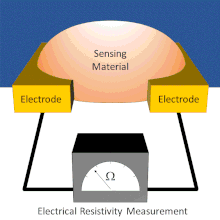 Global Information
Global InformationChemiresistor information

A chemiresistor is a material that changes its electrical resistance in response to changes in the nearby chemical environment.[1] Chemiresistors are a class of chemical sensors that rely on the direct chemical interaction between the sensing material and the analyte.[2] The sensing material and the analyte can interact by covalent bonding, hydrogen bonding, or molecular recognition. Several different materials have chemiresistor properties: semiconducting metal oxides, some conductive polymers,[3] and nanomaterials like graphene, carbon nanotubes and nanoparticles. Typically these materials are used as partially selective sensors in devices like electronic tongues or electronic noses.
A basic chemiresistor consists of a sensing material that bridges the gap between two electrodes or coats a set of interdigitated electrodes. The resistance between the electrodes can be easily measured. The sensing material has an inherent resistance that can be modulated by the presence or absence of the analyte. During exposure, analytes interact with the sensing material. These interactions cause changes in the resistance reading. In some chemiresistors the resistance changes simply indicate the presence of analyte. In others, the resistance changes are proportional to the amount of analyte present; this allows for the amount of analyte present to be measured.
- ^ Florinel-Gabriel Banica, Chemical Sensors and Biosensors: Fundamentals and Applications, John Wiley and Sons, Chichester, 2012, chapter 11, Print ISBN 978-0-470-71066-1; Web ISBN 0-470710-66-7; ISBN 978-1-118-35423-0.
- ^ Khanna, V.K. (2012). Nanosensors: Physical, chemical, and biological. Boca Raton, FL: CRC Press. ISBN 978-1-4398-2712-3.
- ^ "Chemiresistor - Chemical Microsensors - Microsensors and Sensor Microsystems (MSTC)". Archived from the original on 2014-12-17. Retrieved 2014-12-17.